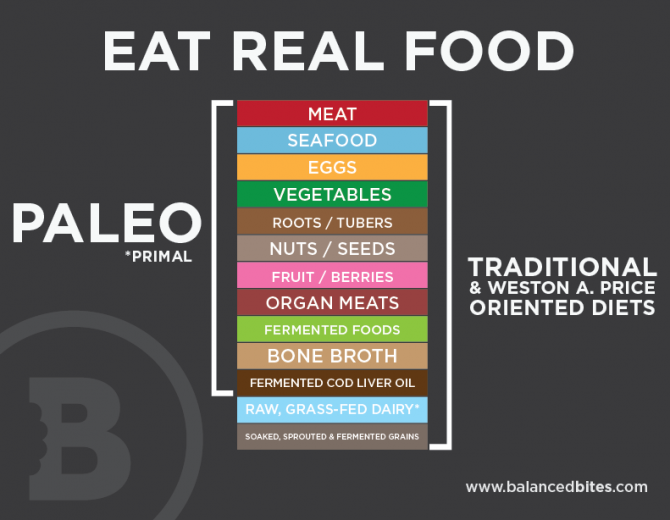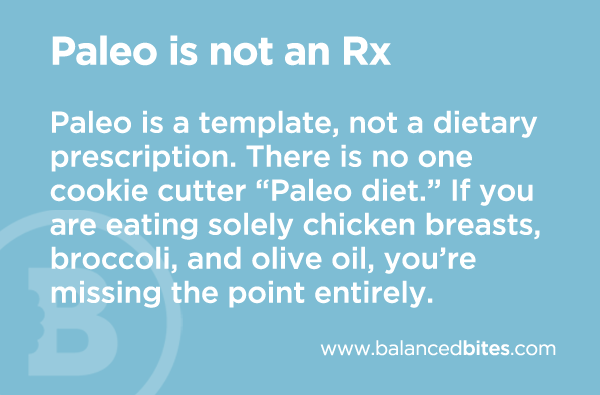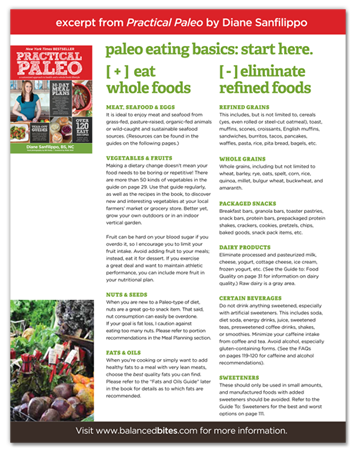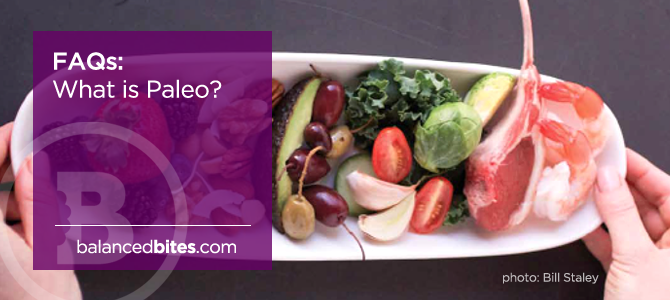“Paleo” is short for Paleolithic, but the name is actually less important than the power of the overall approach.
While the term “Paleo” has gained traction in the mainstream media and on bookstore shelves everywhere due to the improved health of those who follow the lifestyle, you could call it “Primal,” “Grain-Free,” “Real Food,” “Whole Food,” “Nutrient-Dense,” or “Ancestral.”
Whatever name you choose, the “Paleo” way of eating is simple: Mimic our ancestors, who suffered from fewer chronic diseases than modern populations. This doesn’t mean that you’ll recreate a caveman’s food landscape, of course. Our food supply and our environment are different from our ancestors, so we must adapt as new information comes to light.
Click here to download the Paleo Eating Basics PDF.
My approach to explaining a Paleo type of diet is less about demonizing the foods we look to avoid (grains, legumes, pasteurized dairy, and refined foods) and more about helping you to understand how food should work in your body.
 I also think it's important to look beyond the notion of Is it Paleo? and consider including traditional foods that add deep value in nutritional content – foods like organ meats, broths, fermented vegetables and other goodies, and fermented cod liver oil.
I also think it's important to look beyond the notion of Is it Paleo? and consider including traditional foods that add deep value in nutritional content – foods like organ meats, broths, fermented vegetables and other goodies, and fermented cod liver oil.
Once you know how your body should be working with your daily dietary inputs, evaluating if that is in fact happening is the next step. If you are not digesting food well and your blood sugar regulation is off, then eliminating specific foods (as outlined below) is my recommendation as to how to get it working properly. In my book, I get into a lot more detail on how digestion and blood sugar regulation should work, and how you know if they're not – but I imagine most of you reading this are at least somewhat aware of how both of those situations feel.
From my perspective, the Paleo lifestyle is most importantly about:
1 – eating whole foods that provide optimal, nutrient-dense fuel for your body and
2 – avoiding processed, refined, nutrient-poor factory foods.
This means avoiding grains, legumes (beans), refined sugar, and pasteurized dairy products.
People believe eating whole foods is hard and limiting, but it isn’t. It may be an adjustment at first, but it’s simply a matter of eliminating foods that don’t promote health in your body. Though making these changes can be confusing and a bit difficult at first. Trust me, it gets easier!
Once you’ve tackled basic food choices, it is critical to make sure you maintain proper digestive function and blood sugar regulation, then to understand what to do to reach your own personal health goals.
Paleo is not a one-size-fits-all approach, but it’s a way of eating that is appropriate for all human animals. In other words, you are a human animal, so there is a Paleo “plan” that is right for you.
Making paleo work for you
 Before you can land on the best nutritional plan for you, it’s important to understand the basic principles behind this ancestral, real-food way of eating.
Before you can land on the best nutritional plan for you, it’s important to understand the basic principles behind this ancestral, real-food way of eating.
1. Eat whole foods.
If a food is not in its whole, natural form, chances are that it has been refined and is a less than optimal choice. When we intellectualize our diet and remove ourselves, as human animals, from the complex web that defines nature, we fight against our birthright of health. When you eat food as provided by nature, it actually promotes health, healing, and immunity against future ailments.
2. Avoid modern, processed, and refined foods.
These include grains, pasteurized dairy products, industrial seed oils (like corn, cottonseed, soybean, canola, or rapeseed), and artificial or refined sugar and sweeteners—especially high fructose corn syrup. If it has to pass through a factory before it is edible for you, reconsider whether or not it is actually food. More likely, it is an “edible product” or “food-like-substance.”
3. Eat to maintain proper digestive function.
Your requirements for digestive function may be different from someone else depending on your constitution. Essentially, you must determine which foods your body cannot tolerate and stop eating them. For example, some people can tolerate dairy, or the occasional grain-based foods. When you experience symptoms of food intolerances, it is your body’s way of telling you that you are disrupting your digestion.
Why is it so critical not to disrupt digestion?
The ability to fight chronic, and even acute, disease states begins in the digestive system (the gut).
Sixty to eighty percent of the immune system is within the gut.
There is immune tissue that follows the entire length of your small intestine. You’ll learn more than you ever thought you needed to know about this in the digestion and leaky gut sections of my book. If your body constantly suffers from digestive irritation, you set the stage for suppressed immune function in all other areas. This can result in a condition as innocuous as seasonal allergies or a problem that is much more aggressive like diverticulitis, eczema, psoriasis, or a number of inflammatory and autoimmune conditions.
4. Eat to maintain proper blood sugar regulation.
The amount of time it takes before your hunger kicks in again after a meal and how you feel (besides hungry) entering into your next meal are critical signs of how well your blood sugar levels are managed. If you’re hungry and eating every two to three hours and feeling shaky, weak, or starving entering into each meal or snack, you are probably not eating the right balance of food for you.
Figuring out how much protein, fat, and “good carbs” you should eat will help you to maintain well-balanced blood sugar throughout the day while comfortably eating roughly every four to six hours.
5. Follow a plan that will help you reach your own personal health goals.
People often ask me if I think a Paleo diet is right for everyone. Since Paleo is about is eating healthy food and avoiding unhealthy food — i.e., eating whole foods as opposed to refined foods—then, yes, I think it’s 100% right for everyone. Still, it would be a huge misstep to say that we can and should all eat exactly the same foods.
Does that mean you can try to create a nutritional plan based on what your specific ancestors ate?
 If your bloodline is 100% pure, you could try, but it would still be challenging to find the same foods that were eaten so long ago. Most of us, at least in the United States, are a mixture of different bloodlines from around the world, so it would be impossible to trace the diet of our ancestors.
If your bloodline is 100% pure, you could try, but it would still be challenging to find the same foods that were eaten so long ago. Most of us, at least in the United States, are a mixture of different bloodlines from around the world, so it would be impossible to trace the diet of our ancestors.
Instead, the Paleo concept is based on estimations of what humans of past generations would have eaten, as well as the nutritional and dietary history in many parts of the world.
We can guess what different animal and plant foods would have been available in different climates on different terrain and with varied access to bodies of water. If we were to attempt to recreate early natural diets with 100% accuracy, though, we would have to stretch to find the indigenous plants and animals that were available in the past.
While I propose that there are certain foods that should be considered optimal and included as part of your nutritional landscape, you may very well experience vibrant, long-term, and exemplary health eating foods outside of these recommendations. Someone who eats processed foods and maintains excellent health is hardly the norm, however. Unfortunately, in my experience, this kind of exemplary health is far from what most people are experiencing in the modern world.
Ask yourself some questions.
Beyond your ethnic heritage, you can evaluate your upbringing and foundational nutrition (or lack thereof), as well as your genetic predispositions to health or disease to the best of your ability.
Then, answer these questions regarding your current health status:
- How do you feel most of the time?
- What is the status of your physical fitness or athletic performance?
- How is your body composition in terms of how much fat you have compared to muscle?
- How are your moods?
- Does your energy level fluctuate throughout the day?
- How is your appetite?
- Do you have food cravings? For sugar? For carbs? For salty or fatty foods?
- Does your skin look healthy, clear, and glowing?
- How is your vision?
- How is your dental health?
- Do you have regular bowel movements?
- Have you been diagnosed with a specific health condition?
 If you answered all of these questions positively, congratulations! You’re in a very small minority, and you can skip ahead and search the web for Paleo recipes, or simply use the over 100 easy recipes in Practical Paleo to get going on changing your food.
If you answered all of these questions positively, congratulations! You’re in a very small minority, and you can skip ahead and search the web for Paleo recipes, or simply use the over 100 easy recipes in Practical Paleo to get going on changing your food.
If you simply want to improve your overall health, reviewing the one-page guides throughout my book (most of which are also available here on the website for free download) and following the recipes will get you well on your way.
If you’re like most people, you probably didn’t give a positive answer to all of the questions, which means you would benefit from evaluating your current approach to health and nutrition and working on a plan that's a bit more customized for you.
If you have an existing health condition, set of symptoms, or a specific health goal, read all of the chapters to learn how food operates in your body. Then, proceed to the 30-Day Meal Plans in Practical Paleo to find an approach that may be best for you.
You can identify which plan is right for you by reviewing the introductions to each meal plan, as well as the set of conditions and/or ill-health symptoms that each meal plan is designed to support. In the meantime, my Paleo Eating Basics chart will give you a basic rundown of which foods to eat and which to eliminate for a Paleo lifestyle.
Get more information on choosing a meal plan that's right for you from this podcast episode.
Click here to download the Paleo Eating Basics PDF.
Some of my other favorite, “What is Paleo” posts:
from Cave Girl Eats, (or her awesome, “Is it Paleo” post, or her Good Nutrition in 100 Words guide)
from FitBomb
from Primal Palate


Comments 32
Thanks for all you do to make Paleo and ‘Real Food’ so clear. Your passion and knowledge are inspirational!
Thanks for reading, Brenda!
Awesome information!
Ha!
Thanks for making the information so accessible to the average person and not being the “paleo police!” I read a lot about the Paleo movement and some people are so “do or die” about it. I find your approach quite refreshing and well suite for any lifestyle–thank you!
Really appreciated your take on going Paleo. I hate even to use the word sometimes, because people get so weird about it. 😀
this is a real clear snapshot for anyone who needs to really understand paleo, and I like the way you say it’s less about the name “paleo” than the approach to eating whole foods…that is really powerful. gonna share!
I’ve been ‘trying’ to go paleo for a month or so now. Not doing a good job at it tho. Your book was recommended to me, I ordered it today. Look forward to reading it and getting a better understanding of it all.
It should help a lot! 🙂
So great! thank you! 🙂
What I love about this is that you are so real. You explained everything so clearly and it wasn’t too scientific. Sometimes I get so lost with the science of paleo that I get overwhelmed. 🙂
If I only eat things from the list but exclude some of them am I still considered to be eating “paleo”?
For example, I refuse to eat green vegetables. I eat a variety of fruits, other vegetables, nuts, etc.
My wife says I’m not eating healthy (or paleo) because I don’t eat those green leafy veggies. But when I ask her to give me the vitamin or mineral I am missing out on by not eating the greens (something that I can’t get from another source) she can’t tell me what that is.
Short answer: Yes.
Longer answer: Not everyone can or should eat the same foods within what is considered to be “Paleo.” Leafy greens are great for many, but some don’t love the taste (they can be quite bitter, but I recommend cooking them in coconut oil and trying them that way!), and some don’t digest them well. There are definitely nutrients that are rich in leafy greens that we don’t find many other places as richly like magnesium and vitamin K1 – but if you enter your diet into a nutrition calculator and look for shortcomings in nutrients, seek out those nutrients in other foods if you don’t like leafy greens. She’s right to push you to eat everything in the scope of what is considered Paleo, but the reality here is that TONS of people have intolerances or issues digesting so many foods, that to say that those people won’t be healthy by not eating a few foods that are considered Paleo is off the mark in my opinion.
I love eggs and want everyone to eat them, but many can’t – it doesn’t mean they’re going to miss out entirely – it just means seeking similar nutrients elsewhere is a good idea.
Love this resource!! Thanks for the obviously hard work putting it together. I’ve got it bookmarked for the next time someone looks at me crosseyed and asks “WHAT kind of lifestyle??” Saves me the effort.
Hi Diane,
I loved the article and I believe everything that you have said about the diet. Actually I bought this cookbook several months ago from a friend of mine.
http://cooklikeacaveman.com/paleo-cookbook-review/
Couldn’t be any happier with the results. I think my favorite part of it is the nature of the whole diet. I think I’ve really adjusted well to it. People just need to see the results, it’s splendid.
Met an individual today who has been following this eating style for sometime and has seen amazing results. My interest comes because I have chronic, debilitating pain among other health issues. I’ve tried a gluten free diet, and it truly didn’t have a life changing effect on me as i’ve heard from others. This may be the key. Thank you for giving me a basic understanding.
Awesome, Angelina! I think you’ll also find my book, “Practical Paleo,” VERY useful in your journey. If you’d like to check it out… > http://amzn.to/practicalpaleo
Met an individual today who has been following this eating style for sometime and has seen amazing results. My interest comes because I have chronic, debilitating pain among other health issues. I’ve tried a gluten free diet, and it truly didn’t have a life changing effect on me as i’ve heard from others. This may be the key. Thank you for giving me a basic understanding.
Awesome, Angelina! I think you’ll also find my book, “Practical Paleo,” VERY useful in your journey. If you’d like to check it out… > http://amzn.to/practicalpaleo
This is such a great post. I have been eating and cooking Paleo since I did the Whole30 and also read your book, Practical Paleo. I was a life-long “low fat, semi-vegetarian” and I have never felt better in my life!
I am desperately trying to get my parents (overweight, joint problems, arthritis, psoriasis etc.) to accept that their food choices are impacting their well-being.
They hate the “paleo” name and think it’s just a fad so it’s a challenge (understatement) to say the least.
Anyway, thanks for all of the great information – it really is helpful and making a difference!
This is such a great post. I have been eating and cooking Paleo since I did the Whole30 and also read your book, Practical Paleo. I was a life-long “low fat, semi-vegetarian” and I have never felt better in my life!
I am desperately trying to get my parents (overweight, joint problems, arthritis, psoriasis etc.) to accept that their food choices are impacting their well-being.
They hate the “paleo” name and think it’s just a fad so it’s a challenge (understatement) to say the least.
Anyway, thanks for all of the great information – it really is helpful and making a difference!
I hope Sally sees this.
I would love to improve my overall health and with that I’d like to understand what works for my individual body better. I want to understand me better. Having said that, I don’t know where to start. In this article you say we need to evaluate whether or not our body is working properly. I’ve always struggled with that. I’m unsure whether or not I’m digesting certain foods properly or not? I’m not one to get a lot of stomach aches, but every now and then I do. Like for the past two days I’ve gotten stomach aches after a meal I’ve ate around 2:00 and then still feeling upset when dinner time rolls around. Not sure where to begin to understand what works for me. Would love your help 🙂
Do you have my book? It will help you work through all of this.
thanks for getting back to me, sweetie, you’re amazing for that 🙂 I DO have your book, of course! <3 I just bought it last week, but started school at the same time, too, so haven't had a chance to start reading! I will soon, though. Thank you for all of your help <3
So ultimately, the book helps you determine whether or not you’re digesting food properly? 🙂 I read all of your posts on digestion, but I assume the book provides me with even more information on if I am digesting properly or not? 🙂
I think those occasional stomach aches are caused by indigestion. Not usually caused by the food you ate. It may be caused by overeating or eating too fast. If you are planning to get yourself in the Paleo diet, you must first know the type of foods involved in the diet. Then, maybe consult your doctor to see which foods you will have problems with. For a food list, I highly recommend this website. Good Luck.
I would love to improve my overall health and with that I’d like to understand what works for my individual body better. I want to understand me better. Having said that, I don’t know where to start. In this article you say we need to evaluate whether or not our body is working properly. I’ve always struggled with that. I’m unsure whether or not I’m digesting certain foods properly or not? I’m not one to get a lot of stomach aches, but every now and then I do. Like for the past two days I’ve gotten stomach aches after a meal I’ve ate around 2:00 and then still feeling upset when dinner time rolls around. Not sure where to begin to understand what works for me. Would love your help 🙂
Why have you listed Quinoa as a grain? Quinoa is a seed and does not come from the Poaceae family, of which all grains are a member.
Why have you listed Quinoa as a grain? Quinoa is a seed and does not come from the Poaceae family, of which all grains are a member.
I don’t think you could be more correct with that pyramid, Diane!
I love the list of questions included in this post. Good reference point to take an honest look at oneself and consequent health status. And..it was great to meet you yesterday. As I have 2 of your new cookbooks now, I’m trying to decide which cook in my circle of friends and family will use it well and consequently be a worthy recipient. Nabil’s contribution to the book-signing event was great, by the way. Quite the charmer – I liked the personal back story that contributed to the book’s creation. Lastly, I am loving the format of the book, with nutritionist and chef tips, as well as the picture index. Thanks for sharing your brilliance with the rest of us. (Btw, had a totally tormenting dream last night that I was supposed to drive you to the airport and no matter how hard I tried, I kept failing. Couldn’t leave on time, headed for the wrong airport, stuck in traffic. Lord, it was exhausting!)